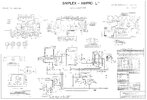paddy ryan
Member
Hi again,
I am gradually losing the plot on my restoration of the projector valve amp. I have replaced all capacitors, and have the amp live and working, but no Gain. I can just about hear the film soundtrack through the speakers if I put my ear to it! I have changed and checked all valves, but notice that the 6BR7 valve seems dead. It is always cold and theres no glow. I have changed it a couple of times with spares, but no joy. The base connections all look okay. I am a beginner in this field and have no sophisticated gadgets to check further, any advice please.
Secondly,on my Ampro Premier 20, the amp is completely dead. The fuse blows when I turn it on. I have checked by sight the fuse line to the transformer and can can see nothing wrong there. I have ordered a new rectifier valve to see if that works, but any advice please on these two problems. many thanks
I am gradually losing the plot on my restoration of the projector valve amp. I have replaced all capacitors, and have the amp live and working, but no Gain. I can just about hear the film soundtrack through the speakers if I put my ear to it! I have changed and checked all valves, but notice that the 6BR7 valve seems dead. It is always cold and theres no glow. I have changed it a couple of times with spares, but no joy. The base connections all look okay. I am a beginner in this field and have no sophisticated gadgets to check further, any advice please.
Secondly,on my Ampro Premier 20, the amp is completely dead. The fuse blows when I turn it on. I have checked by sight the fuse line to the transformer and can can see nothing wrong there. I have ordered a new rectifier valve to see if that works, but any advice please on these two problems. many thanks


